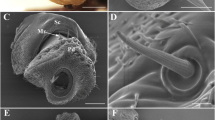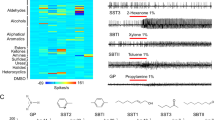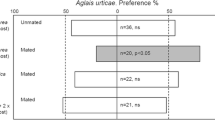Abstract
The nasal botfly Oestrus ovis (Diptera, Cyclorrhapha: Oestridae) is a myiasis-causing insect species, which affects the health of sheep, goats and humans. Gravid females are viviparous and larviposit into the animal’s nostrils. Host-searching and larvipositing flies are visually guided and influenced by climatic conditions, whereas olfaction seemed to play no role in this process. However, here, we show that the antennae of adult O. ovis female flies are relatively small but well developed and inhabited by several types of olfactory sensilla. Further, we show that the antennal lobes of this species receive input from antennal afferents and consist of a clearly defined glomerular organisation. We also give the first evidence of the fly’s ability to detect several synthetic odour compounds. Our findings provide a morpho-functional basis for future investigations on olfactory-mediated behaviour of this insect pest.







Similar content being viewed by others
References
Anderson JR, Nilssen AC (1996) Trapping oestrid parasites of reindeer: the relative age, fat body content and gonotrophic conditions of Cephenemyia trompe and Hypoderma tarandi females caught in baited traps. Med Vet Entomol 10:347–353. doi:10.1111/j.1365-2915.1996.tb00754.x
Anderson JR, Olkowski W (1968) Carbon dioxide as an attractant for host-seeking Cephenemyia females (Diptera: Oestridae). Nature 220:190–191. doi:10.1038/220190a0
Angioy AM, Tomassini Barbarossa I, Crnjar R, Liscia A, Pietra P (1987) Reflex cardiac response to various olfactory stimuli in the blowfly, Protophormia terraenovae. Neurosci Lett 81:263–266. doi:10.1016/0304-3940(87)90393-4
Ashworth JR, Wall R (1994) Responses of the sheep blowflies Lucilia sericata and L. cuprina to odour and the development of semiochemical baits. Med Vet Entomol 8:303–309. doi:10.1111/j.1365-2915.1994.tb00093.x
Bernier UR, Kline DL, Barnard DR, Schreck CE, Yost RA (2000) Analysis of human skin emanations by gas chromatography/mass spectrometry. 2. Identification of volatile compounds that are candidate attractants for the yellow fever mosquito (Aedes aegypti). Anal Chem 72:747–756. doi:10.1021/ac990963k
Bowen MF (1992) Terpene-sensitive receptors in female Culex pipiens mosquitoes: electrophysiology and behaviour. J Insect Physiol 38:759–764. doi:10.1016/0022-1910(92)90028-C
Budavari S (ed) (1989) Merck index. Merck, Rahway
Cepeda-Palacios R, Scholl PJ (2000) Factors affecting the larvipositional activity of Oestrus ovis gravid females (Diptera: Oestridae). Vet Parasitol 91:93–105. doi:10.1016/S0304-4017(00)00265-X
Colwell DD, Scholl PJ (1995) Cuticular sensilla on newly hatched larvae of Gasterophilus intestinalis and Oestrus ovis. Med Vet Entomol 9:85–93. doi:10.1111/j.1365-2915.1995.tb00121.x
Dekker T, Ibba I, Siju KP, Stensmyr MC, Hansson BS (2006) Olfactory shifts parallel superspecialism for toxic fruit in Drosophila melanogaster sibling. D Sechellia Curr Biol 16:101–109. doi:10.1016/j.cub.2005.11.075
Delhaes L, Bourel B, Pinatel F, Cailliez JC, Gosset D, Camus D, Dei-Cas E (2001) Human nasal myiasis due to Oestrus ovis. Parasite 8:289–296
Dethier VG, Yost MT (1952) Olfactory stimulation of blowflies by homologous alcohols. J Gen Physiol 35:823–839
Dethier VG, Larsen JR, Adams JR (1963) The fine structure of the olfactory receptors of the blowfly. In: Proc First Intern Symp Olfaction and Taste. Pergamon, New York, pp 105–110
Dorchies P, Alzieu JP (1997) L’oestrose ovine: revue. Rev Med Vet 148:565–574
Eisemann CH (1988) Upwind flight by gravid Australian sheep blowflies, Lucilia cuprina (Wiedmann) (Diptera: Calliphoridae), in response to stimuli from sheep. Bull Entomol Res 78:273–279. doi:10.1017/S0007485300013031
Geier M, Bosch JO, Boeckh J (1999) Ammonia as an attractive component of host odour for the yellow fever mosquito, Aedes aegypti. Chem Senses 24:647–653. doi:10.1093/chemse/24.6.647
Hribar LJ, Leprince DJ, Foil LD (1992) Ammonia as an attractant for adult Hybomitra lasiophthalma (Diptera: Tabanidae). J Med Entomol 29:346–348
Hunter FF, Adserballe CF (1996) Cuticular structures on the antennae of Hypoderma bovis De Geer (Diptera: Oestridae) females. Int J Insect Morphol Embryol 25:173–181. doi:10.1016/0020-7322(95)00013-5
Ignell R, Dekker T, Ghaninia M, Hansson BS (2005) Neuronal architecture of the mosquito deutocerebrum. J Comp Neurol 493:207–240. doi:10.1002/cne.20800
Ilchmann G, Betke P, Grafe D, Gossing S (1976) Untershungen zue oestrose und ihre bekampfung in der Mongolishen Volksrepublik. Monatsh Veterinärmed 41:128–132
Jacquiet P, Dorchies P (2002) Towards a lower prevalence of Oestrus ovis infections in sheep in a temperate climate (south west France). Vet Res 33:449–453. doi:10.1051/vetres:2002031
Jeanbourquin P, Guerin PM (2007) Chemostimuli implicated in selection of oviposition substrates by the stable fly Stomoxys calcitrans. Med Vet Entomol 21:209–216. doi:10.1111/j.1365-2915.2007.00685.x
Kaib M (1974) The receptors of meat-odour and flower-odour on the antennae of the blowfly Calliphora vicina. J Comp Physiol 95:105–121
Keil TA (1999) Morphology and development of the peripheral olfactory organs. In: Hansson BS (ed) Insect olfaction. Springer, Berlin, pp 5–47
Kendra PE, Montgomery WS, Mateo DM, Puche H, Epsky ND, Heath RR (2005) Effect on age on EAG responses and attraction of female Anastrepha suspense (Diptera: Tephritidae) to ammonia and carbon dioxide. Environ Entomol 34:584–590
Kristoffersen L, Larsson MC, Anderbrant O (2008a) Functional characteristics of a tiny but specialized olfactory system: olfactory receptor neurons of carrot psyllids (Homoptera: Triozidae). Chem Senses 33:759–769. doi:10.1093/chemse/bjn034
Kristoffersen L, Hansson BS, Anderbrant O, Larsson MC (2008b) Aglomerular hemipteran antennal lobes-basic neuroanatomy of a small nose. Chem Senses 33:771–778. doi:10.1093/chemse/bjn044
Lee YH, Park SU (2002) Estimation of ammonia emission in South Korea. Water Air Soil Pollut 135:23–37. doi:10.1023/A:1014771314751
Mackie RI, Stroot PG, Varel VH (1998) Biochemical identification and biological origin of key odour components in livestock waste. J Anim Sci 76:1331–1342
Nilssen AC, Tommeras BA, Schmid R, Evensen SB (1996) Dimethyl trisulphide is a strong attractant for some calliphorids and a muscid but not for the reindeer oestrids Hypoderma tarandi and Cephenemyia trompe. Entomol Exp Appl 79:211–218. doi:10.1007/BF00343341
Pampiglione S, Giannetto S, Virga A (1997) Persistence of human myiasis by Oestrus ovis L. (Diptera: Oestridae) among shepherds of the Etnean area (Sicily) for over 150 years. Parassitologia 39:415–418
Papadopoulos E, Prevot F, Diakou A, Dorchies P (2006) Comparison of infection rates of Oestrus ovis between sheep and goats kept in mixed flocks. Vet Parasitol 138:382–385. doi:10.1016/j.vetpar.2006.02.023
Park KC, Cork A (1999) Electrophysiological responses of antennal receptor neurons in female Australian sheep blowflies, Lucilia cuprina, to host odours. J Insect Physiol 45:85–91. doi:10.1016/S0022-1910(98)00102-4
Sánchez-Andrade R, Romero JL, Suárez JL, Pedreira J, Díaz P, Arias M, Paz-Silva A, Panadero R, Díez-Baños P, Morrondo P, Scala A (2005) Comparison of Oestrus ovis metabolic and somatic antigens for the immunodiagnosis of the zoonotic myiasis oestrosis by immunoenzymatic probes. Immunol Invest 34:91–99
Scala A, Solinas G, Citterio CV, Kramer LH, Genchi C (2001) Sheep oestrosis (Oestrus ovis Linné 1761, Diptera: Oestridae) in Sardinia, Italy. Vet Parasitol 102:133–141. doi:10.1016/S0304-4017(01)00515-5
Scala A, Paz-Silva A, Suárez JL, López C, Díaz P, Díez-Baños P, Sánchez-Andrade Fernández R (2002) Chronobiology of Oestrus ovis (Diptera: Oestridae) in Sardinia, Italy: guidelines to chemoprophylaxis. J Med Entomol 39:652–657
Shanbhag SR, Müller B, Steinbrecht RA (1999) Atlas of olfactory organs of Drosophila melanogaster 1. Types, external organization, innervation and distribution of olfactory sensilla. Int J Insect Morphol Embryol 28:377–397. doi:10.1016/S0020-7322(99)00039-2
Shcherban NF (1973) Prevention of Oestrus ovis infestation (trichlorfon aerosol). Veterinarya 2:71–72 (in Russian)
Smallegange RC, Qiu YT, van Loon J, Takken W (2005) Synergism between ammonia, lactic acid and carboxylic acids as kairomones in the host-seeking behaviour of the malaria mosquito Anopheles gambiae sensu stricto (Diptera: Culicidae). Chem Senses 30:145–152. doi:10.1093/chemse/bji010
Steinbrecht RA (1997) Pore structure in insect olfactory sensilla: a review of data and concepts. Int J Insect Morphol Embryol 26:229–245. doi:10.1016/S0020-7322(97)00024-X
Stensmyr MC, Urru I, Collu I, Celander M, Hansson BS, Angioy AM (2002) Rotting smell of dead-horse arum florets. Nature 420:625–626. doi:10.1038/420625a
Stocker F (2001) Drosophila as a focus in olfactory research: mapping of olfactory sensilla by fine structure, odor specificity, odorant receptor expression, and central connectivity. Micr Res Tech 55:284–296. doi:10.1002/jemt.1178
Stocker RF, Lienhard MC, Borst A, Fischbach K-F (1990) Neuronal architecture of the antennal lobe in Drosophila melanogaster. Cell Tissue Res 262:9–34. doi:10.1007/BF00327741
Strausfeld NJ (1976) Atlas of an insect brain. Springer, Berlin
Tømmerås BA, Wibe A, Nilssen AC, Anderson JR (1993) The olfactory response of the reindeer nose botfly, Cephenemyia trompe (Oestridae), to components from interdigital pheromone gland and urine from the host reindeer, Rangifer tarandus. Chemoecology 4:115–119. doi:10.1007/BF01241681
Tømmerås BA, Nilssen AC, Wibe A (1996) The two reindeer parasites, Hypoderma tarandi and Cephenemyia trompe (Oestridae), have evolved similar olfactory receptor abilities to volatiles from their common host. Chemoecology 7:1–7. doi:10.1007/BF01240631
Touré SM (1994) Les myiases d’importance économique. Rev Sci Tech Off Int Epizoot 13:1053–1073
van Kranenburg R, Kleerebezem M, van Hylckama VJ, Ursing BM, Smit BA, Ayad EHE, Smit G, Sieze RJ (2002) Flavour formation from amino acids by lactic acid bacteria: predictions from genome sequence analysis. Int Dairy J 12:111–121. doi:10.1016/S0958-6946(01)00132-7
Welch JB (1988) Effect of trap placement on detection of Cochliomyia hominivorax (Diptera: Calliphoridae). J Econ Entomol 81:241–245
Zumpt F (1965) Myiasis in man and animals in the old word. Butterworths, London
Acknowledgements
This work was supported by the Ministero dell’Istruzione, dell’Università e della Ricerca, Italy (Ph.D. grant to S.P.); Linnaeus grant, IC-E3, to the Division of Chemical Ecology, SLU, Alnarp, Sweden; and the Regione Autonoma della Sardegna, Italy (research programme APQ, project P5a).
Author information
Authors and Affiliations
Corresponding author
Rights and permissions
About this article
Cite this article
Poddighe, S., Dekker, T., Scala, A. et al. Olfaction in the female sheep botfly. Naturwissenschaften 97, 827–835 (2010). https://doi.org/10.1007/s00114-010-0700-0
Received:
Revised:
Accepted:
Published:
Issue Date:
DOI: https://doi.org/10.1007/s00114-010-0700-0




